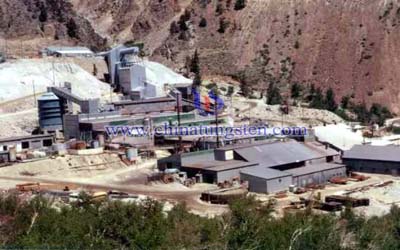Famous Tungsten Mine – Pine Creek Tungsten Mine
- Details
- Category: Tungsten Information
- Published on Friday, 09 June 2017 11:26
Prospectors located mining claims along famous tungsten mine - Pine Creek Tungsten Mine high up in the rugged Sierra Nevada west of Bishop in 1895, but the gold and silver content of the assayed rock proved too disappointing.
The ground lay dormant until 1916, when Billie Vaughn and Arch Beauregard discovered outcrops with molybdenum and the tungsten-bearing mineral scheelite while prospecting near the headwaters of Pine Creek. Vaughn and Beauregard filed on claims situated at an elevation of 11,300 feet above sea level, and with two other partners extended the 7-mile-long trail from Round Valley for another three miles. Pack mules transported equipment and supplies up the steep 3,000-foot slope, including a concentrating table that had to be cut up into sections.

The claims were worked during and shortly after World War I to produce scheelite concentrates, which were packed down the trail on mule back. Tungsten extracted from the scheelite was used to make durable steel alloys, and thus was in high demand during wartime. Because of this demand, tungsten increased in value fivefold from that of the pre-war years. The partners soon realized that they did not have the financial means to develop the deposit on a large enough scale to make mining profitable, and by January 1918 had struck a deal with a new partner who obtained the needed capital. New trails and roads were built, power lines and pipelines were constructed, and mine timbers were cut using an electric-powered sawmill that was packed in on mules. Upon completion of the Rock Creek wagon road, which used part of the old Sherwin toll road, machinery for the mines and a mill was transported from the railroad station at Laws, a distance of 50 miles by the new wagon road. The mill went into operation in December 1918 but was forced to close two months later due to plummeting tungsten prices.
The Natural Soda Products Company purchased the Pine Creek mine in 1922 and then reorganized as the Tungsten Products Company. Tungsten prices had risen somewhat since the 1919 crash, and the company moved ahead with improvements. In 1924, an adit was driven that shortened the distance from the mine to the mill, improving winter operations. Ore was hauled to the surface by mules pulling six-car trains and then transported to the mill via rail tram. The Rock Creek road was abandoned due to the difficulty of keeping it open during winter, so most supplies were hauled to the mine by pack mules via the Pine Creek trail. The concentrates carried down the trail on mule back were transported by road to the railroad station at Laws. Although problems due to weather conditions persisted, optimism ran high; unfortunately, by 1928 the mine workings and mill were idle once again due to events related to the 1927 Watterson Bank failure.
The Pine Creek mine lay dormant until 1936, at which time the US Vanadium Corporation acquired the property and began developing it into a world-class producer of tungsten. Transportation remained a challenge due the remote location and harsh winter conditions. Horses and mules continued to be used to pack materials and supplies into the early 1940s. George Brown, a Paiute Indian from Round Valley, was foremost among the packers of this era, carrying everything from drill rods and power poles to timbers, cable, and bull wheels for construction of a 2.5-mile-long tramway to the Tungsten Mine, situated at an elevation of 12,000 feet above sea level on the east face of Mt. Tom. According to some accounts, construction of the tramway was the last big commercial/industrial packing job in the Eastern Sierra. Completed in December 1941, this tram was probably the last all-wood construction project of its kind in the United States. The towers were built high enough for tram buckets to clear the large amounts of snow that accumulated in the winter. In addition to carrying ore, the tram was used to bring in supplies for snowbound employees and transport injured workers out of the mine.
After completion of the road over 11,000-foot Morgan Pass in 1939 and the tramway in 1941, the need for pack mules diminished. Heavy duty Lynn half-trucks began making regular trips over the arduous Morgan Creek Road. When the road was choked with snow, bulldozers were used to pull sleds laden with supplies. During big snowstorms, the mine was cut off from the outside world for weeks at a time. At such times, Tex Cushion and his dog team made numerous trips to deliver mail and supplies and to respond to medical emergencies, sometimes during raging blizzards.
| Tungsten Supplier: Chinatungsten Online www.chinatungsten.com | Tel.: 86 592 5129696; Fax: 86 592 5129797;Email:sales@chinatungsten.com |
| Tungsten News & Prices, 3G Version: http://3g.chinatungsten.com | Molybdenum News & Molybdenum Price: http://news.molybdenum.com.cn |



 sales@chinatungsten.com
sales@chinatungsten.com